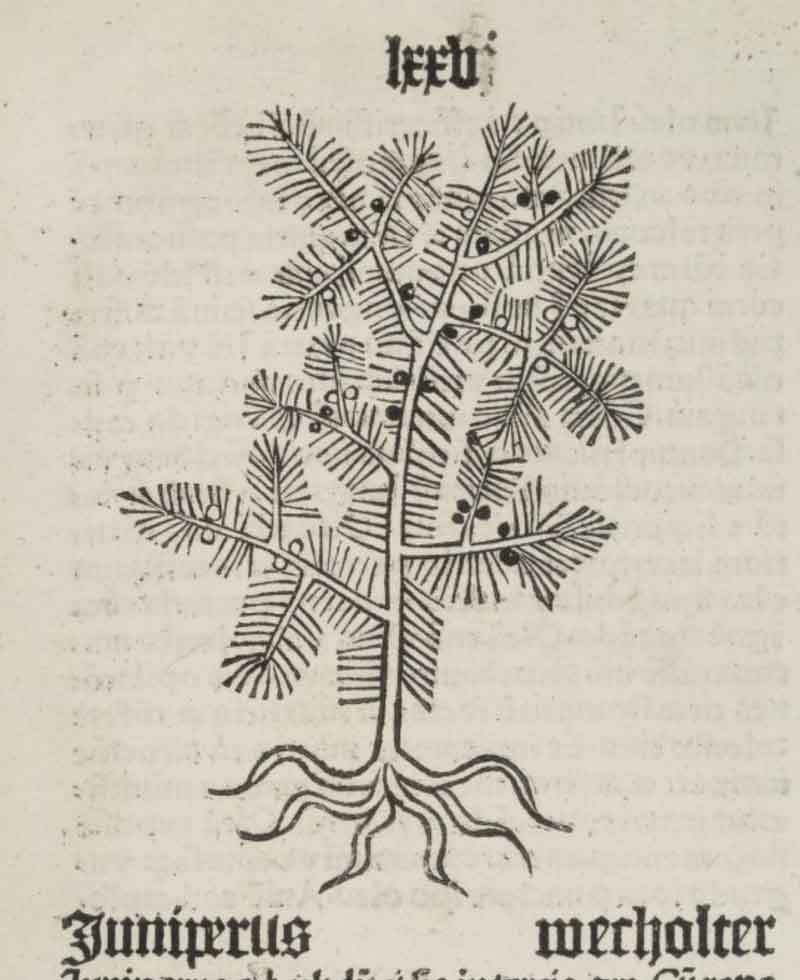the shade of yew, to those sleeping under;
Original French: l’umbre de If, aux dormans deſſoubs:
Modern French: l’umbre de If, aux dormans dessoubs:
Among the examples of pairings whose antipathies are not as vehement as the hatred thieves have of a certain usage of Pantagruelion.
Notes
Juniperus
Taxus

Taxus
Taxus baccata L.
Ancient Greek: smilax
Modern French: if
the shade of yew
Pliny xvi. 10, § 25 [?]; Plut. Symp. iii. f 44 [?]
the shade of yew
Similis his etiamnunc aspectu est, ne quid praetereatur, taxus minime virens gracilisque et tristis ac dira, nullo suco, ex omnibus sola bacifera. mas noxio fructu, letale quippe bacis in Hispania praecipue venenum inest: vasa etiam viatoria ex ea vinis in Gallia facta mortifera fuisse conpertum est. hanc Sextius milacem a Graecis vocari dicit, et esse in Arcadia tam praesentis veneni ut qui obdormiant sub ea cibumve capiant moriantur. sunt qui et taxica hinc appellata dicant venena quae nunc toxica dicimus, quibus sagittae tinguantur. reperio innoxiam fieri si in ipsam arborem clavus aereus adigatur.
Moreover, not to pass over any variety, resembling these trees in appearance is the yew, hardly green at all in colour and slender in form, with a gloomy, terrifying appearance; it has no sap, and is the only tree of all the class that bears berries. The fruit of the male yew is harmful — in fact its berries, particularly in Spain, contain a deadly poison; even wine-flasks for travellers made of its wood in Gaul are known to have caused death. Sextius says that the Greek name for this tree is milax, and that in Arcadia its poison is so active that people who go to sleep or picnic beneath a yew-tree die. Some people also say that this is why poisons were called ‘taxic,’ which we now pronounce ‘toxic’ [Taxica from taxus, a yew; toxica from τόξον, a bow]. meaning ‘used for poisoning arrows.’ I find it stated that a yew becomes harmless if a copper nail is driven into the actual tree.
l’umbre de if, aux dormans dessoubs
If, Taxus baccata, L. (Junipéracée) — L’ombrage de l’if est dangereux, dit Dioscoride, surtout quand il est en fleur, ajoute Plutarque: «Ut qui obdormaint sum ea cibumve capiant moriantur», enchérit Pline, XVI, 20. Mais Pena et Dalechamps assurent le contraire, et avec raison. Les observations d’éruption miliaire rapportées en 1789 par Harmand de Montgarni ne semblent pas relever de cette cause. L’if renferme un alcaloïde, la taxine de Marmé, et un glucoside, la taxicatine de Lefebvre. Mail ils ne sont pas volatils; on n’a observé d’empoisonnements que par ingestion de druples chez les enfants ou de feuillage chez les équidés. (Paul Delaunay)
Nenuphar…
Encore une fois, la plupart de ces exemples se retrouvent dans le De latinis nominibus de Charles Estienne. Le nenufar et la semence de saule sont des antiaphrodisiaques. La ferula servait, dans l’Antiquité, à fustiger les écoliers (cf. Martial, X, 62-10).
shade of the ash tree
folia earum iumentis mortifera, ceteris ruminantium innocua Graeci prodidere; in Italia nec iumentis nocent. contra serpentes vero suco expresso ad potum et imposita ulceri opifera ut nihil aeque reperiuntur; tantaque est vis ut ne matutinas quidem occidentesve umbras, cum sunt longissimae, serpens arboris eius adtingat, adeo ipsam procul fugiat. experti prodimus, si fronde ea circumcludantur ignis et serpens, in ignes potius quam in fraxinum fugere serpentem. mira naturae benignitas prius quam hae prodeant florere fraxinum nec ante conditas folia demittere.
Greek writers have stated that the leaves of the ash are poisonous to beasts of burden, though doing no harm to all the other kinds of ruminants; but in Italy they are harmless to beasts of burden also. Indeed, they are found to be serviceable as an exceptionally effective antidote for snake-bites, if the juice is squeezed out to make a potion and the leaves are applied to the wound as a poultice; and they are so potent that a snake will not come in contact with the shadow of the tree even in the morning or at sunset when it is at its longest, so wide a berth does it give to the tree itself. We can state from actual experiment that if a ring of ash-leaves is put round a fire and a snake, the snake will rather escape into the fire than into the ash-leaves. By a marvellous provision of Nature’s kindness the ash flowers before the snakes come out and does not shed its leaves before they have gone into hibernation.
